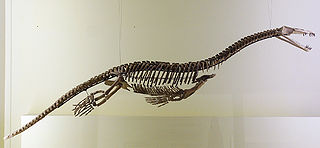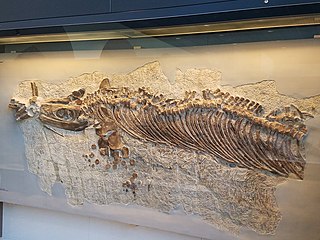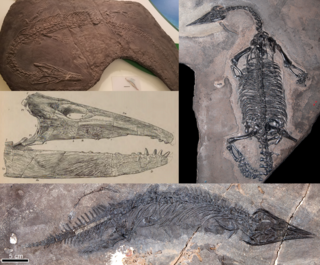
Nothosaurus is an extinct genus of sauropterygian reptile from the Triassic period, approximately 240–210 million years ago, with fossils being distributed from North Africa and Europe to China. It is the best known member of the nothosaur order.

Placodonts are an extinct order of marine reptiles that lived during the Triassic period, becoming extinct at the end of the period. They were part of Sauropterygia, the group that includes plesiosaurs. Placodonts were generally between 1 and 2 m in length, with some of the largest measuring 3 m (9.8 ft) long.

Pachypleurosauria is an extinct clade of primitive sauropterygian reptiles from the Triassic period. Pachypleurosaurs vaguely resembled aquatic lizards, with elongate forms ranging in size from 0.2–1 metre (0.66–3.28 ft), with small heads, long necks, paddle-like limbs, and long, deep tails. The limb girdles are greatly reduced, so it is unlikely these animals could move about on land. The widely spaced peg-like teeth project at the front of the jaws, indicating that these animals fed on fish. In the species Prosantosaurus, it was observed that they fed on small fishes and crustaceans which they devoured entirely and that its teeth regrew after they broke off. This was the first observation of tooth replacement in a European pachypleurosaur, with the only other discovery of such an event having been made in China.

Cymbospondylus is an extinct genus of large ichthyosaurs, of which it is among the oldest representatives, that lived from the Lower to Middle Triassic in what are now North America and Europe. The first known fossils of this taxon are a set of more or less complete vertebrae which were discovered in the 19th century in various mountain ranges of Nevada, in the United States, before being named and described by Joseph Leidy in 1868. It is in the beginning of the 20th century that more complete fossils were discovered through several expeditions launched by the University of California, and described in more detail by John Campbell Merriam in 1908, thus visualizing the overall anatomy of the animal. While many species have been assigned to the genus, only five are recognized as valid, the others being considered synonymous, doubtful or belonging to other genera. Cymbospondylus was formerly classified as a representative of the Shastasauridae, but more recent studies consider it to be more basal, view as the type genus of the Cymbospondylidae.

Ceresiosaurus is an extinct aquatic genus of lariosaurine nothosaurid sauropterygian known from the Middle Triassic of Monte San Giorgio, southern Switzerland and northern Italy. Ceresiosaurus, meaning "Lizard of Ceresio". The type species, Ceresiosaurus calcagnii, was named by Bernhard Peyer in 1931. C. calcagnii is known from both the Cava superiore and Cava inferiore beds of the Lower Meride Limestone at Monte San Giorgio, dating to the latest Anisian of the Middle Triassic. Rieppel (1998) suggested that the back then monospecific genus Ceresiosaurus, is a junior synonym of the better known Lariosaurus, yet he kept it type species as a separate species under the new combination L. calcagnii. In 2004, however, this synonymy was objected by Hänni who described and name a second species of Ceresiosaurus, C. lanzi - a separation supported by several other authors since. This species is known only from the stratigraphically younger Cassima beds of Monte San Giorgio, although also from the Lower Meride Limestone, dating to possibly the lowest Ladinian age. The species in a subtropical lagoonal environment with varying open marine influences, and alongside many related but smaller species of nothosaurids and pachypleurosaurids. Ceresiosaurus represents one of the largest vertebrate of up to 3 m (9.8 ft) snout-tail length from the very diversified paleoenvironment of the Middle Triassic Monte San Giorgio.

Cyamodus is a genus of placodonts known from several species described from Middle-Late Triassic of Europe and China. The genus was described by Christian Erich Hermann von Meyer in 1863, based on specimens found in Germany. Like some other placodonts, Cyamodus has an armoured carapace composed of irregular hexagonal plates, with the mouth containing a small number of large, rounded teeth that were likely involved in crushing hard shelled organisms (durophagy).

Thalattosauria is an extinct order of marine reptiles that lived in the Middle to Late Triassic. Thalattosaurs were diverse in size and shape, and are divided into two superfamilies: Askeptosauroidea and Thalattosauroidea. Askeptosauroids were endemic to the Tethys Ocean, their fossils have been found in Europe and China, and they were likely semiaquatic fish eaters with straight snouts and decent terrestrial abilities. Thalattosauroids were more specialized for aquatic life and most had unusual downturned snouts and crushing dentition. Thalattosauroids lived along the coasts of both Panthalassa and the Tethys Ocean, and were most diverse in China and western North America. The largest species of thalattosaurs grew to over 4 meters (13 feet) in length, including a long, flattened tail utilized in underwater propulsion. Although thalattosaurs bore a superficial resemblance to lizards, their exact relationships are unresolved. They are widely accepted as diapsids, but experts have variously placed them on the reptile family tree among Lepidosauromorpha, Archosauromorpha, ichthyosaurs, and/or other marine reptiles.

Macrocnemus is an extinct genus of archosauromorph reptile known from the Middle Triassic of Europe and China. Macrocnemus is a member of the Tanystropheidae family and includes three species. Macrocnemus bassanii, the first species to be named and described, is known from the Besano Formation and adjacent paleontological sites in the Italian and Swiss Alps. Macrocnemus fuyuanensis, on the other hand, is known from the Zhuganpo Formation in southern China. A third species, Macrocnemus obristi, is known from the Prosanto Formation of Switzerland and is characterized by gracile limbs. The name Macrocnemus is Greek for "long tibia".

Helveticosaurus is an extinct genus of diapsid marine reptile known from the Middle Triassic of southern Switzerland. It contains a single species, Helveticosaurus zollingeri, known from the nearly complete holotype T 4352 collected at Cava Tre Fontane of Monte San Giorgio, an area well known for its rich record of marine life during the Middle Triassic.
Wimanius is a genus of ichthyosaur from the Middle Triassic of Switzerland, containing a single species, Wimanius odontopalatus. It was described by Michael Maisch and Andreas Matzke in 1998 based on an incomplete skull from Monte San Giorgio, a mountain on the Swiss-Italian border. Wimanius possesses teeth on its palate, though whether they were located on the palatine or pterygoid is disputed. Other features of Wimanius include a large orbit and jugals with two rami of similar lengths. Different phylogenetic placements of Wimanius have been recovered by different studies, including it being a mixosaurid relative or a merriamosaur, and a monotypic family, Wimaniidae has been named for it. However, its validity has also been questioned, and synonymy with various other genera has been proposed. The only specimen of Wimanius come from the Besano Formation. During the Anisian, this region was a lagoon populated by a wide variety of marine life, including a variety of other ichthyosaurs.

Sinosaurosphargis is an extinct genus of basal marine saurosphargid reptile known from the Middle Triassic Guanling Formation of Yunnan and Guizhou Provinces, southwestern China. It contains a single species, Sinosaurosphargis yunguiensis.
Largocephalosaurus is an extinct genus of basal saurosphargid, a marine reptile known from the Middle Triassic Guanling Formation of Yunnan and Guizhou Provinces, southwestern China. It contains a type species, Largocephalosaurus polycarpon, and a second species L. qianensis.
Hanosaurus is an extinct genus of marine reptiles that existed during the Triassic period in what is now China. The type species is Hanosaurus hupehensis. It was a small animal, with specimens measuring 79.4 cm (31.3 in) long in total body length, which likely fed on soft-bodied prey.

The Erfurt Formation, also known as the Lower Keuper, is a stratigraphic formation of the Keuper group and the Germanic Trias supergroup. It was deposited during the Ladinian stage of the Triassic period. It lies above the Upper Muschelkalk and below the Middle Keuper.

Saurosphargidae is an extinct family of marine reptiles known from the Early Triassic and early Middle Triassic of Europe and China.
Saurosphargis is an extinct genus of a basal marine reptile, saurosphargid, known from the Middle Triassic of southwestern Poland and eastern Netherlands. It contains a single species, Saurosphargis volzi.

Eusaurosphargis is an extinct genus of a diapsid reptile, known from the Middle Triassic Besano Formation of northern Italy and Prosanto Formation of south-eastern Switzerland. It contains a single species, Eusaurosphargis dalsassoi. It was a small reptile, measuring 20 cm (7.9 in) long.
The Besano Formation is a geological formation in the southern Alps of northwestern Italy and southern Switzerland. This formation, a thin but fossiliferous succession of dolomite and black shale, is famous for its preservation of Middle Triassic (Anisian–Ladinian) marine life including fish and aquatic reptiles. It is exposed in the Monte San Giorgio and Besano area. It is among the formations responsible for the area being designated as a UNESCO World Heritage Site. In Switzerland, it is also known as the Grenzbitumenzone. The Anisian-Ladinian boundary lies in the upper part of the Besano Formation.
The Zhuganpo Formation is a Triassic geologic unit found in southern China. It has historically been known as the Zhuganpo Member of the Falang Formation. A diverse fossil assemblage known as the Xingyi biota or Xingyi Fauna can be found in the upper part of the Zhuganpo Formation. Fossils of the Xingyi biota include articulated skeletons of marine reptiles, abundant fish, and a plentiful assortment of invertebrates indicating a Ladinian to Carnian age for the sediments of the formation.



















